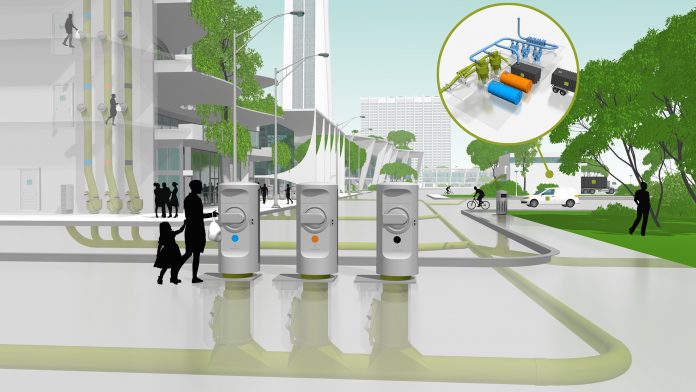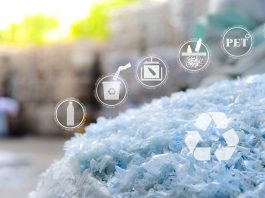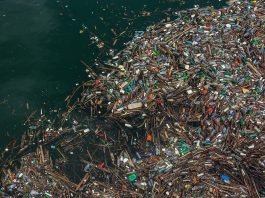Envac is driving advancements in automated waste collection for a cleaner and more efficient waste management system in a rapidly evolving world.
As the world continues to evolve at a rapid pace, the area of automated waste collection is also undergoing significant advancements. Envac, a prominent leader, is committed to driving progress towards a cleaner and more efficient waste management system.
One of the considerable benefits of automated waste collection is its high degree of automation. With its advanced vacuum system, the technology significantly reduces the need for manual labour, makes the waste collection process more hygienic, and reduces its environmental impact. Apart from automation, it also profoundly impacts cleanliness and hygiene. Swiftly removing waste from public spaces minimises the spread of diseases and promotes better hygiene. This is particularly important for hospitals where patients and staff need a safe and healthy environment. Additionally, it has the potential to lower expenses while simultaneously enhancing productivity.
How does the Envac system work?
The Envac system only requires users to interact with the waste inlet, where they deposit their waste. The inlets are typically placed within 30 metres of residential or office buildings in a group, with separate inlets for each type of waste. Users sort their waste at home and dispose of it in the appropriate unit, making the sorting process simple and encouraging recycling.
Compared to traditional waste rooms or bins, the inlets are completely sealed, minimising unpleasant smells, mess, and unsanitary conditions, as well as reducing the risk of vermin. The waste inlets are connected to an underground pipe network, and emptying occurs when the inlets are full, improving energy efficiency. The waste is transported through the pipe network using negative airflow that sucks the bags to a remote collection station at a speed of 70km/h. Emptying takes only a few minutes per waste stream.
Being underground makes the Envac system resilient to extreme weather events, and with smart automation, it remains reliable even during times of societal pressure. The waste collection station can be two kilometres, or further, from the central urban area, reducing the impact of heavy traffic, such as noise, air pollution, and traffic jams. All the waste streams are transported through a single pipe network, with each waste stream emptied separately and directed to the corresponding waste container at the collection station. The air used for transportation is cleaned through an industrial filter before it is released from the building.
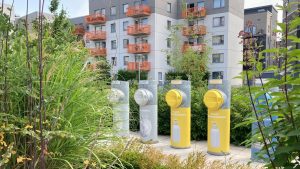
When a container is full, a standard collection vehicle takes it away for processing, reducing heavy waste-related traffic and carbon emissions by up to 90% compared to traditional, multiple collections. This makes the Envac system key to achieving sustainable urban development goals and creating a greener planet. Digitalisation has significantly impacted waste collection in recent years, allowing waste management companies to monitor their operations, leading to more efficient and cost-effective waste collection processes. For example, sensors are installed in waste inlets to detect when they are full, enabling the system to be energy efficient.
Automated waste collection solution for sustainable and resilient urban development
Data-driven, intelligent waste collection and recycling are instrumental in making urban development sustainable and resilient, especially in densely populated areas. The Envac system is a smart solution that collects information on use and performance 24/7, providing data and intelligence to optimise system performance. The system can be integrated with other city-specific platforms and software to streamline flows and create synergies, contributing to the United Nations’ Sustainable Development Goals of making cities and human settlements safe, resilient, and sustainable.
In the circular economy supporting the smart city, economic value and sustainability go hand in hand with technological advancements using data collection. Municipalities can analyse big data from different city services, such as water, electricity, transportation, and automated waste collection. Smart services for residents can be innovated, and sustainable and efficient resource planning can be achieved for waste management. The need for well-planned and connected green areas is increasingly important in creating more resilient and attractive cities. The Envac system moves waste management underground, freeing more space for people, bicycles, and recreation. This eliminates the need to build access and transport infrastructure for waste collection vehicles and replace bulky recycling stations with lean waste inlets. The system handles most recyclables and waste, making it easy for users to access and efficiently use non-recyclable waste for biogas or electricity production, district heating, or composting.
25 years of environmental benefits in Lisbon, Portugal
Expo Park in Lisbon has been equipped with Envac’s automated waste collection system since the 1990s. As the system celebrates its 25th anniversary this year, it is worth noting the positive environmental outcomes it has yielded. The system is serving around 40,000 homes and 120,000 inhabitants while eliminating the need for heavy collection vehicles, which has resulted in significant environmental benefits.
The automated waste collection system has transported approximately 240,775 tonnes of waste so far. The system has improved urban planning and management by eliminating heavy-duty collection vehicles and bulky waste storage containers on the streets. From an environmental perspective, it has prevented approximately eight tonnes of carbon emissions annually, equivalent to 232 tonnes over the last 25 years. Additionally, it has eliminated 15 tonnes of nitrogen oxide and 58 tonnes of carbon monoxide over time.
The Expo Park system is a successful example of enhancing the quality of urban life while preserving the environment. On the 25th anniversary of its operation, Envac reviewed the objectives achieved by this infrastructure at both the urban and environmental levels. The automatic waste collection system works through a 40km underground pipe network that transports waste using an air stream to a consolidation plant. Users dispose of the waste through disposal points known as inlets in public areas or inside their buildings. In the future, it is possible that Envac may utilise clean energy sources like solar energy from photovoltaic panels on-site. This would make the project a prime example of sustainable urban development.
Roberto Rello, Service Director, Envac Region EMEA, said: “The Envac system has been in operation for half a million hours and is available 24/7. The successful installation and operation of the resilient waste collection system at Expo Park in Lisbon for the past 25 years is a testament to the importance of preserving the environment and enhancing the quality of life in urban areas.”
Waste system that preserves the city’s cultural heritage in Norway
Bergen, a city in Norway known for its historical city centre with narrow streets and wooden buildings, has taken innovative steps to preserve its cultural heritage. By choosing an underground pipe-based waste collection system from Envac, Bergen has created a trailblazing solution to traditional bin-based waste collection, making it a global leader in sustainability.
Envac has helped Bergen to achieve its goal of becoming an international sustainability exemplar by installing a closed underground waste collection. Envac designed a system that could handle 50 tonnes of waste per week using airflow alone without requiring on-street presence from waste collection operatives. In 2007, the first phase of the system was installed, and upon completion, Envac’s pneumatic waste collection system will automatically collect the waste of up to 30,000 apartments multiple times daily.
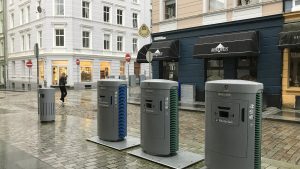
Bergen has won the National Energy Globe Award and, the International Project of the Year Award at the World Congress on Municipal Engineering in Kansas, US for its sustainable urban planning. Using Envac, the City of Bergen has enabled the city to protect and maintain a key part of its cultural legacy and stop further wear and tear on its historical roads caused by waste collection trucks that are too big to move around Bergen’s old, narrow streets effectively. Additionally, it has eliminated the prospect of waste-related fires and burning bins, which would be disastrous for Bergen’s timber buildings, by installing a closed system where fire – and the risk of fire spreading – is no longer possible. With this, Bergen has lowered its insurance premiums due to installing a closed waste collection system that inhibits waste-related fires. It has future-proofed its infrastructure by installing a system that will remain operational for decades, reinforcing Norway’s environmental commitment. Bergen has become the first city to make Envac’s cardboard shredding inlets available by locating them in public areas. In 2023, a new waste collection station of Bergen’s automated waste collection is installed that secures the future for generations to come with one of the world’s most sustainable and smart cities.
Optical sorting: Reducing the impact of waste on the environment
Optical sorting is a next-generation solution for recycling. By utilising optical sorting solutions, cities of all sizes can reduce transport and collection costs by at least 50% compared to other systems. The optical sorting system can be used with the Envac automated waste collection system or can be added to traditional methods of waste collection to modernise them. It is cost-efficient, straightforward, and has increased recycling rates. The system operates through colour-coded bags specific to each recyclable material type. This makes it easy for users to sort their recyclables, even if they are new to recycling. The bags are disposed of in the same waste bin or inlet and transported to the sorting plant, where they are separated based on their colour and placed in their corresponding container. This streamlines transportation and reduces costs and emissions.
Residents and users do the separation of waste from recyclable materials at home. Clear information and easy separation and disposal are key factors for success. Envac’s decades of experience have shown that customising the information campaign together with the system owner drives user engagement.
Envac has successfully implemented the system in the GrowSmarter project at Valla Torg, Stockholm. Households reduced their general waste by 65% after we replaced their old recycling methods in this project. The system collects information on weight per fraction, how well users have done the sorting, how recyclables are disposed of, and much more. This data is used to optimise the system beyond any conventional system. Tech advancements enable the configuration of the system’s capacity and collection intervals and further increase recycling, making the system sustainable and smart.
The optical sorting system can handle recyclables such as food waste, paper packaging, plastic packaging, metal, textiles, newspapers, colourless glass, coloured glass, and combustible waste. With such flexibility, Envac can provide a system that fits every need and any size of city or municipality.
The future for us, and the generations to come
The Envac automated waste collection system is currently being used in various cities across the world, including Paris, Seoul, Stockholm, London, Singapore, Oslo, Hong Kong, and Dubai. In conclusion, Envac provides a sustainable and innovative waste management solution that transforms urban living by reducing manual labour and promoting better hygiene. By integrating with other city-specific platforms, the system can make cities safer, resilient, and sustainable, aligning with sustainable development goals. Envac’s commitment to driving progress towards a cleaner and more efficient waste management system is a promising step towards a better world for future generations.
Please note, this article will also appear in the sixteenth edition of our quarterly publication.

